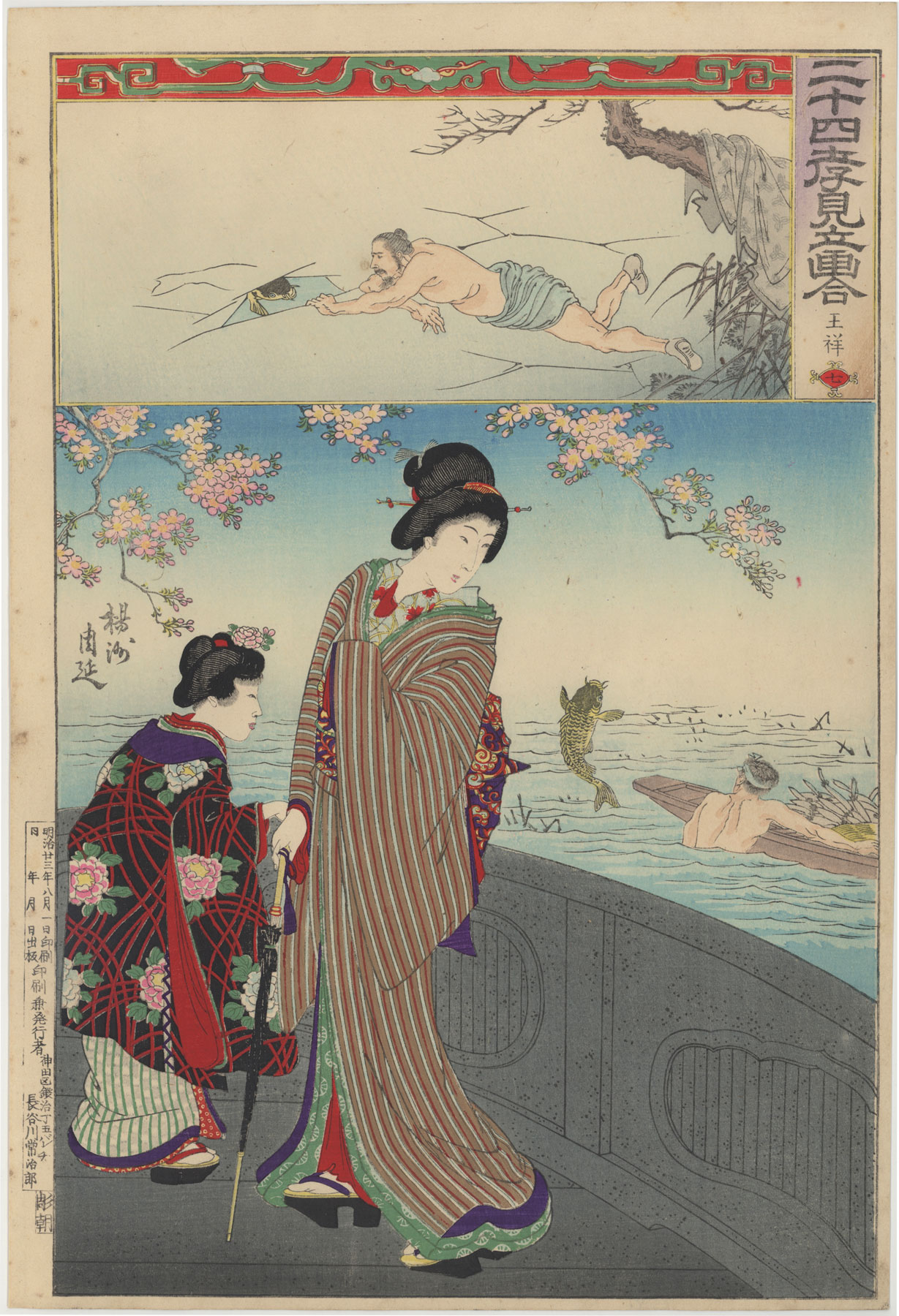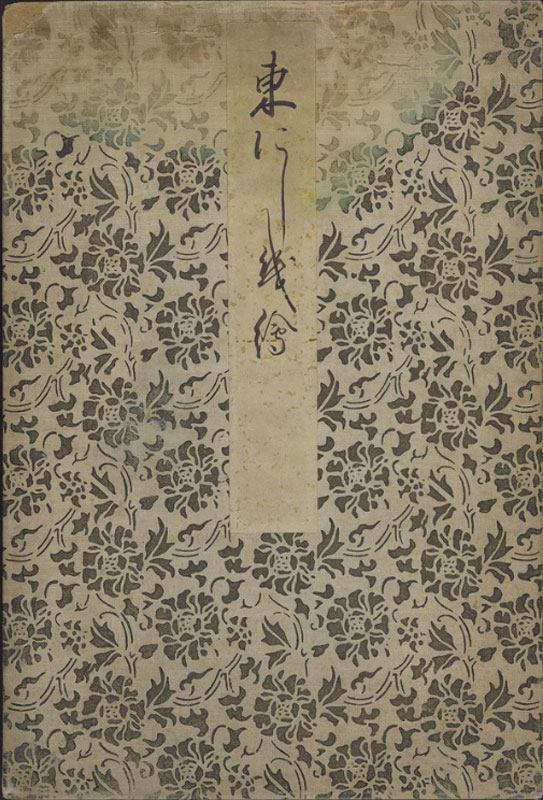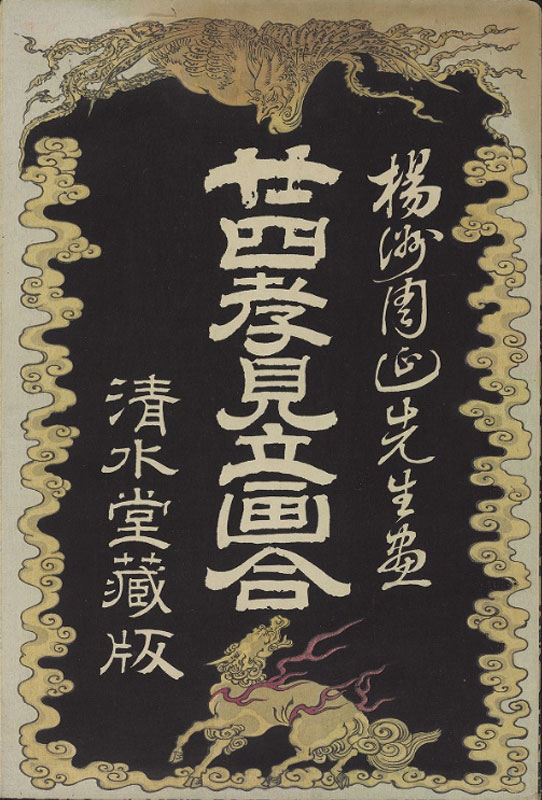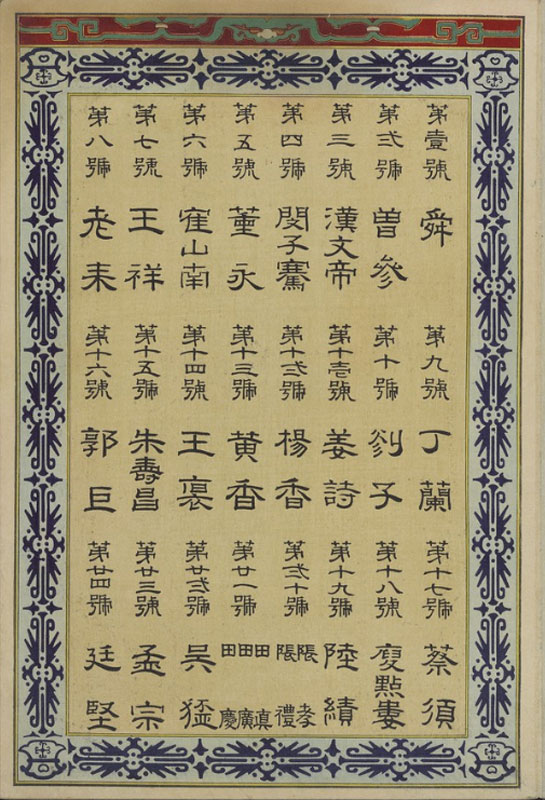About This Print
Sources: Claremont Colleges Digital Library http://ccdl.libraries.claremont.edu/cdm/singleitem/collection/cyw/id/278/rec/13 and my commentary."Among the legends represented in the 24 Paragons of Filial Piety is the story of Wang Xiang (Osho), a third-century court official who, to fulfill his ill stepmother's craving for fresh fish in midwinter, caught some carp by lying on the ice until it melted. Wang Xiang is represented in the upper panel: his robe hangs from the branch of pine while a carp peeks through the hole he has made in the ice. This scene is reflected in the lower panel where a woman and a girl watch a fisherman wading in a lake beside a boat while a large carp leaps in front of him. The flowering cherry tree above them places this in the spring, rather than the winter. Print no. 7 of series."
Given the didactic nature of these prints, we can be sure the mother is relating the above story of Wang Xiang's filial piety to her daughter while watching the young man and the carp.
Throughout the 1890s, Chikanobu produced single sheet prints, diptychs and triptychs, which promoted traditional values and highlighted aspects of Japanese culture that were being forgotten. He created prints about filial piety and neighborhood festivals to provide an alternative to what many saw as the deterioration of Japanese society caused by imported ideas and modern methods.
"[I]n the 1890s, Chikanobu began to show increasing concern for teaching moral values to the new generations, especially to women. Increasingly, women were seen as the protectors of Japanese customs and virtues, while men were expected to cope with Western influences and the modernization process taking place. Beginning in 1890-1891 with Juxtaposed Pictures of Twenty-four Paragons of Filial Piety [Nijūshi ko mitate awase) ... Chikanobu created a series of didactic images that encouraged traditional values found in filial piety, social hierarchies and restrained behavior."
The Series Juxtaposed Pictures of Twenty-four Paragons of Filial Piety
Sources: Chikanobu: Modernity and Nostalgia in Japanese Prints, Bruce A. Coats, Hotei Publishing, 2006, p.46 and my commentary.Throughout the 1890s, Chikanobu produced single sheet prints, diptychs and triptychs, which promoted traditional values and highlighted aspects of Japanese culture that were being forgotten. He created prints about filial piety and neighborhood festivals to provide an alternative to what many saw as the deterioration of Japanese society caused by imported ideas and modern methods.
"[I]n the 1890s, Chikanobu began to show increasing concern for teaching moral values to the new generations, especially to women. Increasingly, women were seen as the protectors of Japanese customs and virtues, while men were expected to cope with Western influences and the modernization process taking place. Beginning in 1890-1891 with Juxtaposed Pictures of Twenty-four Paragons of Filial Piety [Nijūshi ko mitate awase) ... Chikanobu created a series of didactic images that encouraged traditional values found in filial piety, social hierarchies and restrained behavior."
The book entitled "The Twenty-four Paragons of Filial Piety" was written by the Chinese scholar Guo Jujing during the Yuan Dynasty (1279–1368). The book recounts the extremes to which twenty-four sons and daughters go to honor their elders.
In Chikanobu's series he pairs a scene from the original Chinese work with a scene from Japanese life. The two scenes sometimes are visually related and sometimes seemingly unrelated. All the characters in the Japanese scenes are dressed in traditional clothing, in keeping with the intent of these prints to instill moral age-old lessons to modern Japanese woman to pass on to their children.
The two prints in this collection both have a heavy backing paper, indicating they were removed from an album of prints, issued by the publisher Shimizuya Tsunejirō, similar to the album shown below.
Source: Princeton University Digital Library http://pudl.princeton.edu/objects/v979v447m
Album cover | Colophon right: Yōshū Chikanobu sensei ga 楊洲周延先生畫 center: title 二十四孝見立画合 and left: copyright of publisher reading Shimizudō zōhan 清水堂蔵版 | Table of Contents 第壹號舜 第弍號曽參 第三號漢文帝 第四號閔子騫 第五號董永 第六號寉山南 第七號王祥 第八號老来 第九號丁蘭 第十號剡子 第十壱號姜詩 第十弍號楊香 第十三號黃香 第十四號王裒 第十五號朱壽昌 第十六號郭巨 第十七號蔡須 第十八號庾點婁 第十九號陸績 第弍十號張孝張禮 第廿一號田真田廣田慶 第廿弍號吳猛 第廿三號孟宗 第廿四號廷堅 |
Summary of the Original Story from "The Twenty-four Paragons of Filial Piety"
Source: Wikipedia https://en.wikipedia.org/wiki/The_Twenty-four_Filial_Exemplars
"Wang Xiang's mother died when he was young. His stepmother disliked him and often spoke ill of him in front of his father, which resulted in him losing his father's love. However, Wang still remained filial to them and he personally took care of them while they were sick. Once, during winter, Wang's stepmother suddenly had a craving for carp. Wang travelled to the frozen river, undressed, and laid on the icy surface. The ice thawed and Wang was able to catch two carps for his stepmother."
Source: Wikipedia https://en.wikipedia.org/wiki/The_Twenty-four_Filial_Exemplars
"Wang Xiang's mother died when he was young. His stepmother disliked him and often spoke ill of him in front of his father, which resulted in him losing his father's love. However, Wang still remained filial to them and he personally took care of them while they were sick. Once, during winter, Wang's stepmother suddenly had a craving for carp. Wang travelled to the frozen river, undressed, and laid on the icy surface. The ice thawed and Wang was able to catch two carps for his stepmother."
Print Details
| IHL Catalog | #1959 |
| Title or Description | Wang Xiang, No. 7 (Catching Fish for His Stepmother in Winter) 第七號王祥 |
| Series | Juxtaposed Pictures of Twenty-four Paragons of Filial Piety 二十四孝見立画合 nijūshikō mitate awase [also seen translated as The Twenty-four Paragons of Filial Piety with Modern Parallels; A Contrasting Parody of the Twenty-four Paragons of Filial Devotion and Parody of 24 Paragons of Filial Piety] |
| Artist | Yōshū Chikanobu (1838-1912) |
| Signature | 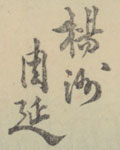 |
| Seal | no artist's seal |
| Publication Date |  Meiji 23rd year, 8th month, first day, printed note: publication/issuance date left blank August 1890 |
| Publisher |  [Marks: pub. ref. 496; seal not shown] |
| Carver |  |
| Impression | excellent |
| Colors | excellent |
| Condition | good – original album backing, light toning and minor soiling |
| Genre | ukiyo-e |
| Miscellaneous |  |
| Format | oban |
| H x W Paper | 13 15/16 x 9 3/8 in. (35.4 x 24.8 cm) |
| H x W Image | 13 5/16 x 8 13/16 in. (33.8 x 22.4 cm) |
| Literature | |
| Collections This Print | Scripps College SC98.4.17; Princeton University Library, Cotsen Children's Library (CTSN). 55216 [entire bound album of 24 prints] |
last revision:
4/24/2020
12/14/2018 created


